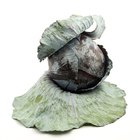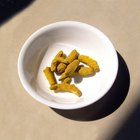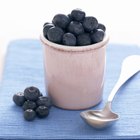
Roxiller/iStock/Getty Images
You may already enjoy eating beets as part of a healthy dinner. But you can also use beets to create sweet and colorful desserts. Baking with beets allows you to use the vegetable's deep red color and natural sweetness to flavor your baked goods and add a vibrant, rich hue naturally. Bake rich-tasting chocolate desserts by adding beets, or use beets for their color to produce a natural, deep-red velvet cake or dye naturally pink Easter eggs.
Sweetening Baked Goods
Baking chocolate goods, such as brownies, with beets can give the brownies a natural sweetness and deepen the final product's dark brown chocolate color. Peel and halve fresh beets, then steam the halves in simmering water until they are very soft. Puree the beet halves in a blender or food processor, then let the puree cool. Add the cooled puree to chocolate brownie or cake batter to add sweetness and a dark, almost purple tint to your sweet treat.
Coloring Baked Goods
Red velvet cake is a traditional chocolate cake that is colored to a deep, brilliant red. Most recipes for red velvet cake call for large quantities of red food coloring. If you prefer to color your food naturally and omit unnatural food dyes from your diet, color your cakes red or pink using beets. Buy a can of beets and use just the juice from the can to add coloring to any cake recipe using the bright red juice. Or steam or roast fresh beets, then grate or puree the cooked, cooled beets, and mix the beet pulp into a cake recipe to add natural color.
Dyeing Eggs
Dyeing eggs at Easter can be a fun family activity, but if you prefer to avoid unnatural food dyes, use beets to create pretty pink eggs. Peel and chop two fresh beets, then bring the beet pieces to boil in 2 cups of water. Strain the beet pieces out of the water and stir 2 tablespoons of vinegar into the beet dye. Once the dye has cooled, use it to dye your eggs in the same way you'd use store-bought egg dye. Note that natural egg dye made from beets creates a softer color than commercial dyes. You might want to let the eggs soak longer in the dye than you normally would to deepen the color.
Homemade Beet Powder
If you prefer to use natural food colorings, purchase or make beet powder to easily add color to a variety of foods and household products. By using beet powder in place of beet juice to color food, you don't add any excess liquid to your recipe. You can also use beet powder to color homemade cosmetics, such as lip gloss. Create your own beet powder by peeling and chopping a fresh beet. Blot the beet pieces with paper towels to remove most of the moisture. Spread the beet parts on a microwave-safe plate lined with parchment paper and cook the beet in the microwave on low power for 30 to 40 minutes, or until the beet pieces are completely dry but still bright red. Grind the dried beet pieces in a coffee or spice grinder, and store the powder in an airtight container at room temperature.
Related Articles

How to Make Blue Food Coloring

Can You Use Beet Powder for Cupcakes?

How to Make Orange Clothes Dye
Can I Substitute Beet Juice for Red ...

How to Make a Healthy Pancake Syrup

Safe Red Food Coloring for Cake Baking

How to Get Tie-Dye Colors to Stay Bright

How to Dye Faded Clothes

How to Dye a T-Shirt Using Beets

How to Make Tie Dye Fondant

How to Darken Jeans

How Do I Use Rit Dye to Make Turquoise ...

How to Make Pink Frosting Without ...

Can I Change the Color of Rolled ...

How to Make Glow in the Dark Eggs

What Makes Food Coloring Darker When ...

How to Get Your Highlights Brighter

How to Dye Hats

How to Freeze Raspberries

How to Flavor White Cake Mix With ...
References
Writer Bio
Leigh Good has been writing for magazines and newspapers for more than 10 years. Her work has been published in numerous print and online publications. Good has a bachelor's degree in print journalism from Georgia State University.
Photo Credits
Roxiller/iStock/Getty Images